Never heard of CP/M you say, in a nut shell it was the computer operating system that started the personal computer software revolution.
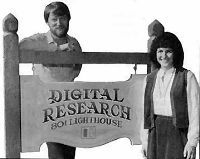 CP/M stands for "Control Program for Microcomputers" and was created by Gary Kildall of Digital Research in the early 1970s and released as a commercial product in the mid 1970s. The original target CPU for CP/M was the Intel 8080 CPU. In 1976 Zilog released there Z80 CPU to the world. The Z80 was binary compatible with the Intel 8080 but had an improved instruction set, and required less external hardware to implement. In a short time the Zilog Z80 became the standard CPU sold in most personal computers running CP/M. CP/M stands for "Control Program for Microcomputers" and was created by Gary Kildall of Digital Research in the early 1970s and released as a commercial product in the mid 1970s. The original target CPU for CP/M was the Intel 8080 CPU. In 1976 Zilog released there Z80 CPU to the world. The Z80 was binary compatible with the Intel 8080 but had an improved instruction set, and required less external hardware to implement. In a short time the Zilog Z80 became the standard CPU sold in most personal computers running CP/M. |
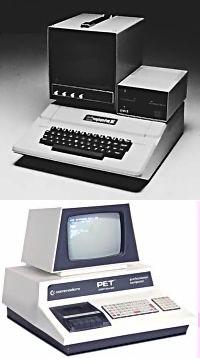 To appreciate why CP/M was so important to the start of the commercial software industry you need to understand the state of the personal computer industry in the late 1970s. The Commodore PET and the Apple computer dominated the desktops of personal computer users. At that time most serious software for personal computers was written in assembly language not in a high level language such as C++ or Pascal (every byte was precious). Assembly language programs take a long time to create and are coded to match the hardware of the computer they run on. If you wrote software for the Apple computer it would take a large number of man hours to port your software to the Commodore PET. Each software program had to contain all the program code to control every piece of the computer's hardware the program required. Even if you could get the software converted to run on another computer model you still had to deal with getting that software to the end user and the user loading the software on there computer. Early computers used a magnetic cassette tape to load and store programs. Programs saved by one computer to tape would often fail to load on another due to tape drive problems. As each computer manufacturer used a different format to store data on there cassette tape different computer systems could not share data tapes. The only safe way to purchase software was on ROM memory cards designed for the computer you owned. Floppy disk drives added in the late 1970s greatly improved the chance you could write some information to the disk and be able to read it back. But with a lack of disk compatibility between different computer manufactures information could not be transferred between computers of different manufactures. In some cases data interchange between programs on the same computer was not even possible. To appreciate why CP/M was so important to the start of the commercial software industry you need to understand the state of the personal computer industry in the late 1970s. The Commodore PET and the Apple computer dominated the desktops of personal computer users. At that time most serious software for personal computers was written in assembly language not in a high level language such as C++ or Pascal (every byte was precious). Assembly language programs take a long time to create and are coded to match the hardware of the computer they run on. If you wrote software for the Apple computer it would take a large number of man hours to port your software to the Commodore PET. Each software program had to contain all the program code to control every piece of the computer's hardware the program required. Even if you could get the software converted to run on another computer model you still had to deal with getting that software to the end user and the user loading the software on there computer. Early computers used a magnetic cassette tape to load and store programs. Programs saved by one computer to tape would often fail to load on another due to tape drive problems. As each computer manufacturer used a different format to store data on there cassette tape different computer systems could not share data tapes. The only safe way to purchase software was on ROM memory cards designed for the computer you owned. Floppy disk drives added in the late 1970s greatly improved the chance you could write some information to the disk and be able to read it back. But with a lack of disk compatibility between different computer manufactures information could not be transferred between computers of different manufactures. In some cases data interchange between programs on the same computer was not even possible. |
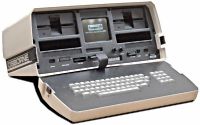 CP/M changed all that. Computers that run CP/M must contain a BIOS that is used by software programs to access the computer system's hardware in a constant manner no matter what CP/M computer the software is running on. CP/M allowed software programs to be loaded onto any CP/M system using the IBM developed floppy disk drive. The BDOS portion of the CP/M operating system makes it possible for software programs to store and retrieve information on a floppy disk drive in a consistent manner. With CP/M, software programs can interchange information, print and even execute each other. Now if you wrote a program to run under CP/M the program did not need to know about the computer hardware in order to execute. The software program could be sent on a standard formatted floppy disk and it should work on all CP/M based computers. While we take this for granted today back in the 1970s no one had combined all these features into a commercial operating system for personal computers. CP/M changed all that. Computers that run CP/M must contain a BIOS that is used by software programs to access the computer system's hardware in a constant manner no matter what CP/M computer the software is running on. CP/M allowed software programs to be loaded onto any CP/M system using the IBM developed floppy disk drive. The BDOS portion of the CP/M operating system makes it possible for software programs to store and retrieve information on a floppy disk drive in a consistent manner. With CP/M, software programs can interchange information, print and even execute each other. Now if you wrote a program to run under CP/M the program did not need to know about the computer hardware in order to execute. The software program could be sent on a standard formatted floppy disk and it should work on all CP/M based computers. While we take this for granted today back in the 1970s no one had combined all these features into a commercial operating system for personal computers. |
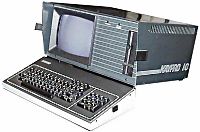 At the time CP/M arrived computer hardware makers did not put much value in software, they wanted to sell computers. A computer manufacturer who used CP/M would only have to write the BIOS for the operating system to load, and any third party CP/M software program could run on there computer. The computer manufacturers could devote more resources to hardware development and not worry about the software, just the way they wanted it. Within a short period of time nearly all personal computers used CP/M as there primary operating system, or offered a means to use CP/M on there computers. There were few Apple computers that did not have a Microsoft CP/M add on card installed to run CP/M software. Even Commodore finally came out with the C128 with its dual 6510 and Z80 CPUs to run CP/M. The large install base of CP/M based computers drew in many software developers, all after a piece of the exploding personal computer software market. At the time CP/M arrived computer hardware makers did not put much value in software, they wanted to sell computers. A computer manufacturer who used CP/M would only have to write the BIOS for the operating system to load, and any third party CP/M software program could run on there computer. The computer manufacturers could devote more resources to hardware development and not worry about the software, just the way they wanted it. Within a short period of time nearly all personal computers used CP/M as there primary operating system, or offered a means to use CP/M on there computers. There were few Apple computers that did not have a Microsoft CP/M add on card installed to run CP/M software. Even Commodore finally came out with the C128 with its dual 6510 and Z80 CPUs to run CP/M. The large install base of CP/M based computers drew in many software developers, all after a piece of the exploding personal computer software market. |
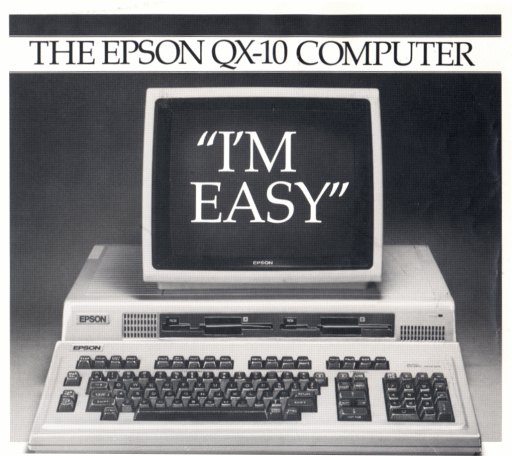 The first commercial release of CP/M was version 1.4 and required 8" floppy disks. The next version of CP/M, version 2.0 added support for 5.25" floppy disks and improved hardware independence. By far the most used version of CP/M was version 2.2b, this was the last update to the CP/M 2.x operating system software. At the peak of CP/M usage, software programs such as WordStar, DBase and SuperCalc where bringing in hundreds of millions for there publishers each year. By the time Digital Research released CP/M version 3.0 the IBM PC was on the market. The IBM PC came with Intel's new 8086 16 bit CPU, and the Z80 was simply out classed. Zilog was working on the Z800 to compete with the Intel's 8086/8088 CPU but the project completed five years late. By the time the Z800 was ready the IBM PC was the dominant personal computer and PCDOS had replaced CP/M as the most used personal computer operating system. Word Perfect and Lotus 123 replaced WordStar and SuperCalc while DBase made the switch to PCDOS and continued on. The first commercial release of CP/M was version 1.4 and required 8" floppy disks. The next version of CP/M, version 2.0 added support for 5.25" floppy disks and improved hardware independence. By far the most used version of CP/M was version 2.2b, this was the last update to the CP/M 2.x operating system software. At the peak of CP/M usage, software programs such as WordStar, DBase and SuperCalc where bringing in hundreds of millions for there publishers each year. By the time Digital Research released CP/M version 3.0 the IBM PC was on the market. The IBM PC came with Intel's new 8086 16 bit CPU, and the Z80 was simply out classed. Zilog was working on the Z800 to compete with the Intel's 8086/8088 CPU but the project completed five years late. By the time the Z800 was ready the IBM PC was the dominant personal computer and PCDOS had replaced CP/M as the most used personal computer operating system. Word Perfect and Lotus 123 replaced WordStar and SuperCalc while DBase made the switch to PCDOS and continued on. |
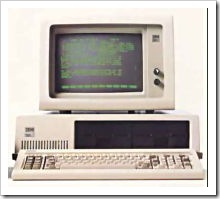 Gary Kildall at Digital Research was one of the first contacted by IBM about an operating system for there new line of personal computers. Unable to make a deal with Digital Research, IBM made a deal with Bill Gates from a small company called Microsoft to produce an operating system for there new personal computer. In 1981 IBM unveiled there IBM PC (personal computer) with Microsoft's PCDOS and the Intel 8086 CPU, the rest is history. PCDOS running on an Intel 8086/8088 CPU was the end of CP/M and Digital Research. Had Digital Research made a deal with IBM to use CP/M on there PC the computer industry may have turned out much differently then it did. Intel quickly became the leading CPU manufacturer for the personal computer. Zilog continued to market there CPUs to the large industrial base the Z80 had developed. Gary Kildall past away in 1994 at age 52. Gary Kildall at Digital Research was one of the first contacted by IBM about an operating system for there new line of personal computers. Unable to make a deal with Digital Research, IBM made a deal with Bill Gates from a small company called Microsoft to produce an operating system for there new personal computer. In 1981 IBM unveiled there IBM PC (personal computer) with Microsoft's PCDOS and the Intel 8086 CPU, the rest is history. PCDOS running on an Intel 8086/8088 CPU was the end of CP/M and Digital Research. Had Digital Research made a deal with IBM to use CP/M on there PC the computer industry may have turned out much differently then it did. Intel quickly became the leading CPU manufacturer for the personal computer. Zilog continued to market there CPUs to the large industrial base the Z80 had developed. Gary Kildall past away in 1994 at age 52.
Caldera bought all of the Digital Research assets from Novell in 1996 and has released all of the source code for Digital Research products. However may third party programs have not been released into the public domain. |






